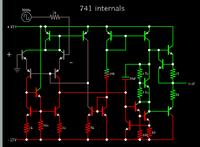elli
Junior Member level 3
i think things going to be very complicated here, so here is the exact question AND i will thank anyone who could help me out with this!
consider this LM741 in open loop with the specifications attached LTspice)
LTspice)

measure the rise and fall time of the output voltage with pulses with given amplitudes: +-5mv , +-5v , +-20mv
consider this LM741 in open loop with the specifications attached

measure the rise and fall time of the output voltage with pulses with given amplitudes: +-5mv , +-5v , +-20mv
